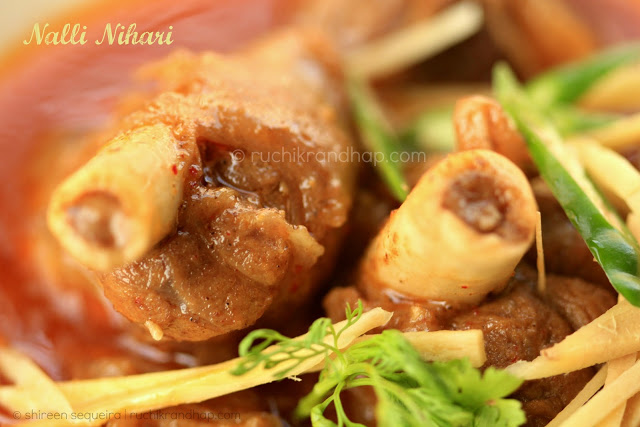When Hubby Cooks’ was a random line I used for one of the first recipes I posted that my husband Roshan had prepared – now it has almost become a monthly series of recipes that he lovingly creates with his expert hands much to the delight of the mouths he feeds at home (and also the readers who end up trying his recipes). Well, thanks to Roshan for putting his passion to good use – our Sunday meals have become a lot more fun and our dining table is a place for great meal time conversations – all revolving around the dish of the day and cuisines of the world.
Well, although you may have heard of the Nalli Nihari did you know that this dish is the National Dish of Pakistan? Our neighbouring country that is always at logger heads with ours and is in the eye of a storm almost all the time is also a place where great food and great music comes from. Beautiful women too 
When Roshan started preparing the dish without using the pressure cooker I was rather tensed. Would we get our afternoon meal on time? I asked him, knowing that here in India the red meat available takes forever to cook without at least the partial use of a pressure cooker. But surprisingly the whole dish – from start to finish – was done under 50 mins or so and was devoured in less than 5 mins. A man who does not like too much of garam masala (blend of spices) in his food was actually making some from scratch – when I saw this, I rolled my eyes and made a quick exit out of the kitchen. You see, we are opposites in our nature and while I totally adore the aroma of fresh garam masala he detests it. Anyway, I waited for the final dish to make its appearance. It quickly got plated and a few hurried clicks later made it to the dining table. The combination of Nalli Nihari with piping hot plain parathas (we buy the ready to fry variety from Al-Kabeer) was out of the world. I wish we had some home made kuboos or a more traditional accompaniment to go with it. As each of us took bites of the paratha dipped in this luxurious curry, we were quickly transported into a different level of gastronomic bliss – nirvana, if you please. Succulent pieces of meat drenched in an aromatic spice rich gravy – a delicacy waiting to be experienced, enjoyed and loved.The most mind blowing part was the subtlety of the garam masala – not overpowering in any way, yet bold enough to make its presence felt and lend that unique taste and aroma to the meat and make Nalli Nihari what it is.
Nalli Nihari
Prep time: 10 mins | Cook time 45mins (approx – depends on the quality/tenderness of meat) | Serves 3-4
- 1 kg lamb/goat meat leg pieces (Nalli)
- 3 tbsp pure ghee
- 2 medium sized onions
- 2 cups lamb stock
- 4 cups water
- 2 tbsp whole wheat flour
- 1 tbsp lime/lemon juice
- 1 inch ginger cut into thin strips (for garnishing)
- 2 tbsp coriander leaves chopped (for garnishing)
- salt to taste
- 3 tsp cumin seeds (jeera)
- 1 1/2tsp fennel seed (saunf)
- 3 long dried red chilies (laal mirch)
- 8 black peppercorns (kali mirch)
- 3 green cardamoms (elaichi)
- 1 black cardamom (badi elaichi)
- 1/2 tsp nutmeg powder (jhaiphal)
- 1/2 tsp dry ginger powder (sunth)
- 1/2 bay leaf (or a small one) (tej patta)
- 1 blade of mace (javitri)
- 4 cloves (laung)
- 1/2 inch stick of cinnamon or cassia bark (dalchini)
- 1 tsp poppy seeds (khus khus)
- 1 tsp roasted bengal gram (chana dal)



Comments
Post a Comment